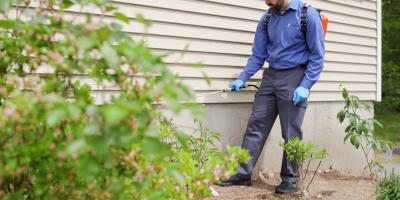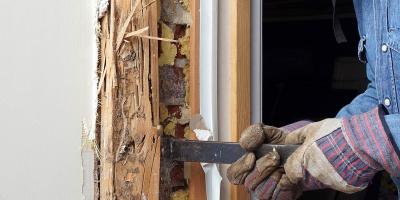Termite Damage? Or Something Else?

If you’re like most Americans, your home is your single greatest asset. You wouldn’t leave all your money in a bank without security or your investments in an unregulated market, right? That’s why you should never own a home without developing a pest management strategy.
Obviously, the most thorough and effective pest management comes from a professional pest monitoring service, but that doesn’t mean you can’t DIY your own pest management system by visually inspecting for warning signs yourself. And if you only learn how to spot the damage from one house-depreciating pest, we recommend that it be the warning signs of the dreaded termite.
Two of a Kind Beat a Full House
Actually, there are two wood-destroying pests you should be on the lookout for: Termites and a species often mistaken for termites – the less-detrimental, but far more common carpenter ant. With both, homeowners tend to notice the damage they leave behind before encountering the pests themselves.
As alike as they are, however, it’s important to know which one you’re dealing with because the treatments are dramatically different for each. Either way, you’ll need a pest control professional with access to materials and techniques not available to an unlicensed DIY exterminator.
Ant vs. Termite: You Lose Either Way
The differences between carpenter ants and termites are subtle but distinct – a trained eye can discern them at a glance, but only because of experience. Many are under the false pretense that termites have wings and ants do not – this is far from the truth. Despite popular belief, ants and termites can have wings, though most members of either species do not. In both cases, it’s only the reproductive members (called “alates”) that sport wings when they’re ready to swarm.
However, this doesn’t mean that you can’t use them to help ID the pest – just take a closer look at their wings’ sizes in proportion to the others, as well as the rest of the insect’s body: Carpenter ants’ wings are unequal in size (the front set is longer than the rear), whereas termites’ four wings are all about equal length.
Carpenter ants have much longer bent antennae and long, lanky hind legs compared to termites, whose straight antennae and legs are all quite short. The shapes of their bodies are even different, with carpenter ants having a defined “waist” area that the cylindrical termite simply doesn’t have.
Separate Species, Different War Paths
Another major difference is the damage each species leaves behind. Termites build distinctive tunnels called “mud tubes” to keep themselves protected, all the while eating the wood along the way (the “mud” is their excrement).
Carpenter ants, on the other hand, don’t eat the wood, they merely excavate it. That’s why their debris appears more like powdery sawdust and the tunnels they dig are smooth (i.e. not filled with “mud”).
The problem is, either way, if left unchecked, carpenter ants and termites will both irrevocably destroy any wood they can get their grubby little jaws on.
As a homeowner, you probably already know that wood makes up the vast majority of the structure of your home (even brick homes). A serious enough termite or carpenter ant infestation could result in a total loss, but even if it doesn’t you could be looking at a repair bill in the tens of thousands, depending on how long the colony has been present.
Thief in the Night
With enough damage to lead to a bill that high, you’d think that you’d see it coming, right? Not usually. Both pests have their own unique ways of staying out of sight, so that even major damage sights can go unnoticed for years if someone isn’t actively looking for it.
Carpenter ants are incredibly common pests that primarily work at night in the safety of your walls, so that typically only the occasional “scavenger” looking for food may be seen. Seeing a couple ants a week won’t sound the alarm for many, since most people are unaware that the one lone ant often signifies hundreds, or even thousands behind-the-scenes.
The local termite species, on the other hand, live primarily underground (hence their name, “subterranean termites.” While the “blue collar” members continue working and excavating 24/7/365, the rest of the colony hides safely underground. This includes the queen, who stays busy laying thousands of eggs per year. This is why it’s essential to recruit a trained professional, who knows how to not only find and kill the colony, but also the queen herself.
Whether you know what’s eating your home or not, we can help. Contact us today to help protect your most valuable asset.



